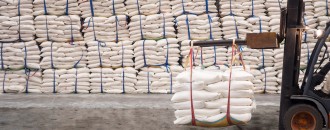
Glimpses from the week that was: Week of 02nd to 08th July
By Abin Daya
With GST now firmly in our midst, we are now getting used to working with the associated processes and systems. The benefits and the impact will take a couple of quarters to understand and evaluate, and till such time, as I have said earlier, all of us will have a very steep learning curve.
In the meantime, RBI has extended the relaxations for caution listed exporters till July 15. Just as well, since the double whammy of GST and caution list restrictions would have been a little too much to deal with at the same time. EDPMS and the exporters’ caution list is definitely not the end of it; IDPMS has already got implemented. Additional developments on this front are expected in due course. Hopefully, we will be able to deal with those better than EDPMS and the exporters’ caution list.
Lower output and decreasing stock levels have helped support sugar prices, and have helped the domestic industry to stage a recovery. The industry has also been asking for a rise in import duties to prevent an oversupply situation in the domestic market. This assumes importance further in the light of an increase in output projected for the next Sugar Year.
Something else which has been on fire recently, so to say, is the FPI inflows into the Indian market. While inflows have been healthy in both equity and debt, FPI debt flows have been at record high levels during Q1 FY18. Barring unforeseen events which might induce undue volatility, we look set to cross the record numbers achieved in 2014-15.
Read on for a detailed update. Please share your comments at [email protected]
Relaxation for caution listed exporters extended till July 15, 2017
- This is a spill-over item from last week – RBI has extended the existing relaxations for caution listed exporters from Jun 30, till Jul 15, 2017
- The relaxations will continue in the same form and manner as they were continuing earlier, and are intended to provide additional time to banks and exporters to rectify the records in EDPMS
- As per the guidelines, relief is available for exporters for whom the outstanding amount under the problem EDFs is up to 20% of total export bills, or the number of export bills remaining open in the system is up to 10 in number
- Exporters who qualify as above will not be considered as caution listed by Authorised Dealers, provided they declare that the proceeds for the said export bills have been realised in full, and eBRCs have been issued by banks
- There might also be cases where proceeds have not yet been realised, and in such cases, the exporter should submit a request for extension of time or for writing off the export bill
- In our workshops, conducted jointly with FIEO, we have been focussing on the process for extension of time and for write-off procedures, with a view to improve the knowledge levels of exporters – the next workshop is in Bangalore on July 26, 2017
- Where the problem export bills are those related to Shipping Bills to be cancelled by Customs, the exporter may submit a declaration to his banker stating that the request is pending with Customs authorities
- The relaxations in caution list restrictions granted by RBI is a direct outcome of the efforts of the Commerce Ministry, driven in large parts by FIEO and other industry bodies
- Originally set to end on May 20, these relaxations were first extended to June 30 and now again, to July 15, 2017
- A direct intervention by the Federation towards the latter half of June 2017 played a large part in the current extension, but it is unclear if RBI would be willing to extend it much further
- The other item that is currently in the works is reportedly a caution list for importers, which could draw from the BEF report submitted by banks, of importers who have made advance payments, but have failed to submit proof of import
- With implementation of IDPMS in Oct 2016, the ground-work has been laid for such a list, but I believe that the regulator would want to have the issues related to EDPMS to settle down, before they move on to the next leg
- It would, however, be prudent to prepare for this, particularly for manufacturers who have a heavy import component in their procurement bill
- With implementation of IDPMS, the concept of settlement of Bill of Entry has been brought in, in the same manner as settlement of Shipping Bill for exports, and the caution list could also be drawn up for exceptions to these
- Subsidiaries of MNCs who have had extended terms of trade provided to them for imports from the parent company or group companies, will need to clean up their books before this hits them
Sugar production to rise on the back of good monsoon
- While the ongoing Sugar Year (SY), set to end 0n Sep 30, 2017, is expected to see a 19% fall in production from the previous year, producers are already anticipating a significantly better SY 2017-18
- Production in the current Sugar Year is estimated to be only 203 lakh tonnes, as against 251 lakh tonnes in the previous year
- Two consecutive years of drought, which had hit acreage under cane cultivation, as also reduced yield during the crushing process were the primary reasons for this shortfall
- The government had permitted duty free import of raw sugar of up to 5 lakh tonnes till June 2012, but the current production, along with opening stock of 69.8 lakh tonnes was sufficient to meet the domestic demand of 230 lakh tonnes
- However, the lower levels of production had all but depleted the reserve stocks, and the country is expected to begin the next Sugar Year on Oct 1, 2017 with enough stocks for barely two months

- Good rains in the cane growing areas has increased the acreage of sugarcane in the ongoing Kharif season, as has also improved the quality of cane available for crushing
- These have raised expectations of better production numbers in the next Sugar Year, at 267 lakh tonnes, an increase of almost 32%, as per a report by Rabobank
- Some analysts have, however, termed the projections as too optimistic, and are pegging production at about 245-250 lakh tonnes in the next year
- The Indian Sugar Mills Association (ISMA) has been pushing for steep increases in import duty of sugar, citing ample availability of sugar in the domestic market
- While the demand is to hike import duty from the current 40% to 60%, it is expected that the government might increase the duty to 50% at the moment
- The government has already increased the Fair & Remunerative Price (FRP) that mills must pay to the growers by 11%, and unless steps are taken to support domestic prices, producers might find it difficult to pay the higher prices
- Apart from this, the government is also considering a higher ethanol price for supplies done to Oil Marketing Companies for the petrol-blending programme
- Sugar is a politically sensitive commodity, and while things are looking up for the industry, events need to be monitored very carefully
FPI investments into Indian debt surge
- FPI investments into debt have been on the rise since the beginning of the current FY, with close to Rs.65,000 cr worth of inflows into debt instruments in Q1 alone

- FPI debt inflows YTD in 2017-18 has already surpassed the whole year inflows for all previous years, except 2014-15
- While Calendar Year 2017 started on a weak note, due to the negative sentiments arising out of the surprise victory of Donald Trump
- The sentiments prevailing in the beginning of the year were in fact continued from the end of 2016
- However, the tide turned in March 2017, when the strong performance of BJP in the UP Assembly elections improved market sentiments
- The inflows have been healthy in the equity segment as well, helping Sensex and NIFTY to hit record high levels
- The strong Rupee and the rising stock market have also helped attract further inflows into the Indian market
- Average inflows into the Indian debt market has been in the range of about Rs.25,000 cr every month since March this year
- While the Fed raising interest rates poses some risk to the overall scenario, these events are already known and factored in currently
- Barring unforeseen events creating significant volatility, the current trend of inflows is expected to continue for some more time

Abin Daya the author of 'Basics of Trade: An India Perspective' is a FEMA expert, a career transaction banker, with close to 15 years of experience in corporate and transaction banking, in India.







 to success.
to success.